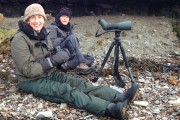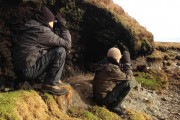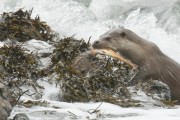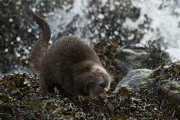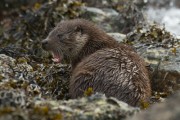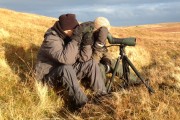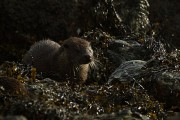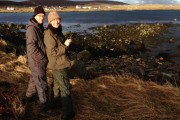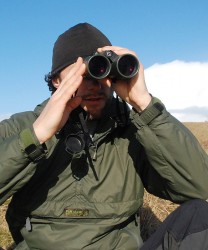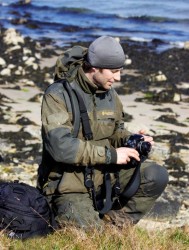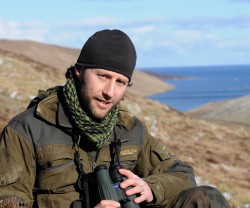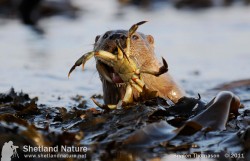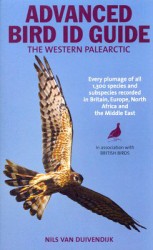Archive for the ‘Reviews’ Category:
Book review: Discover Shetland’s Birds
Posted by Brydon Thomason on Friday 27th November 2015 | Reviews
There are few years that pass without exciting new publications being written about Shetland. We are so very fortunate here to have such an fantastically rich, renowned and fascinating cultural as well as natural heritage. It might be surprising then that since the late Bobby Tulloch published A Guide to Shetland’s Breeding Birds in 1992, such a sought after guide hadn’t been updated for over two decades. Of course The Birds of Shetland, published in 2004 was an outstanding but very different book.
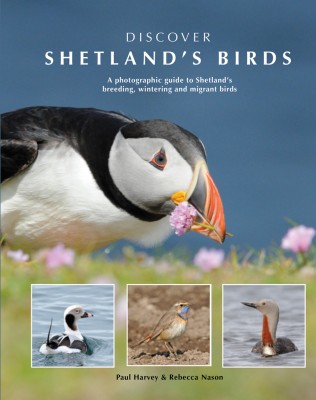 Clearly a photographic guide was well over due and the recently published Discover Shetland’s Birds: A Photographic Guide to Shetland’s Breeding, Wintering and Migrant Birds has gone way beyond expectations to bridge that gap. Published by ‘Shetland Heritage Publications’ the guide concentrates on about 180 of the 450 species recorded in Shetland. With this the authors Paul Harvey and Rebecca Nason target the species visitors are most likely to see throughout the seasons in the Isles.
Clearly a photographic guide was well over due and the recently published Discover Shetland’s Birds: A Photographic Guide to Shetland’s Breeding, Wintering and Migrant Birds has gone way beyond expectations to bridge that gap. Published by ‘Shetland Heritage Publications’ the guide concentrates on about 180 of the 450 species recorded in Shetland. With this the authors Paul Harvey and Rebecca Nason target the species visitors are most likely to see throughout the seasons in the Isles.
Few are better placed to write such a book. Both authors are widely respected ornithologists but the collaboration of Paul’s outstanding in-depth knowledge of the islands birds and Rebecca’s gifted artistic approach to her photography has come together to achieve much more than a field guide. Indeed its physical size and shape wouldn’t really be practical to have in the car or in your rucksack but so engaging and beautifully put together it is that you simply wouldn’t want to take it out the house!
What they have achieved with this book is a modern and simple approach to a bird ID guide that anyone from a garden birdwatcher, lover of wildlife or even the experienced birder can enjoy and learn from. The book begins by introducing the islands birds through from the breeding; wintering and migration season. The focus is then systematically on over 150 main species that are most likely to be seen. Each of these is covered in depth, from how to identify and key features to look for, with images covering different plumages, through to an eye catching and easy to use colour-coded calendar bar to show the months to see them. There are even a few of the scarcer and rarer species to look for, compared alongside the common counterparts.
Following the systematic species guide, which is obviously the main body of the book, they cover a very useful insight and guide into Shetlands birding hotspots and where to watch birds.
Without reservation this is a book that I am thrilled to recommend and to own a copy of myself, which several weeks after receiving I am still lifting off the shelf to enjoy or show friends!
The book is £19.99 in paperback and also available in hardback at £24.99 and can be ordered through Rebecca’s website or the Shetland Heritage Shop.
Permalink
Otter Heaven in Shetland – A visit from Arizona
Posted by Brydon Thomason on Wednesday 5th November 2014 | Otters, Reviews
A lovely account from guests Fiona Clark and Jim Boggs visiting all the way from America on one of our tailored Shetland Otter Experience holidays in February 2014 along with a couple of images from their trip. Their account communicates perfectly the insight and experience that these itineraries offer for guests wanting to really learn about otters, their behavior, ecology and where, when and how to study them. We run itineraries like these all year round but they are particularly recommended during the ‘night and day’ seasons from late autumn through to early spring. Contact us for details on these packages [email protected]
I have something of a magnificent obsession when it comes to otters. When I lived in Seattle, I spent almost all of my free time (plus a lot of time when I was supposedly working on my graduate studies) on a beach in a nearby park, tracking and then eventually watching the North American river otters (Lontra canadensis) that lived there.
In my quest to learn more about these “river” otters that lived on the coast and did their fishing in the sea, I came across the work of Prof. Hans Kruuk, who had done extensive studies on coastal or marine foraging Eurasian otters in Shetland and on the Scottish mainland. While there are some significant differences, the North American river otter and the Eurasian otter share many similarities, and Prof. Kruuk’s work helped me tremendously in understanding my local otters. A seed was also planted: my husband Jim and I clearly needed a trip to Shetland at some point.
Being typically broke students back then, the trip had to wait for a good few years. But in February 2014, Jim and I joined Brydon Thomason in Unst for four days of otter watching. From searching online and reading about Brydon, his knowledge on otters and work he does it was clear he was our man. I liked Brydon from our very first email exchange: he too was a fan of Prof. Kruuk’s work and was clearly an otter enthusiast of the first order. We soon agreed that February would be a fine time for a trip. As with the otters in the Seattle area, Shetland’s otters are usually active in the daytime. In winter, the otters seem to concentrate their activities into a shorter time period since the days are so short. This can make them easier to find and more fun to watch. An added bonus is that you can stay in bed till a civilized time since it would be too dark to see anything if you got up too early.
Brydon picked us up in Lerwick and we talked otters nonstop all the way to the superb lodge at Barrafirth in Unst. Next morning we found a mother and two cubs at the very first place that we stopped to check for otters. We went on to see a staggering 29 different otters over the course of our four days at various sites around the islands along shorelines Brydon studies. And these were not fleeting glimpses of far distant otters. We spent hours watching some of them.
We also saw some otter behaviour that I had only read about, or inferred from seeing otter tracks on my beach. This included watching (and hearing – they were loud!) a courting couple, and also watching two family groups come together. Jim particularly loved to see the cubs play wrestling, and trying to eat fish that were almost as big as they were. He still talks about being so close that we could hear one of the cubs chomping on a fish. Seeing all of the loving interactions between otter mums and their little ones has also stayed with us: I had seen some of this on my beach, of course, but due to the terrain there I had never had such prolonged views of these mother-cub interactions. Knowing my interest in all aspects of otter behavior, Brydon also took us to see otter holts, lay up areas, and bathing pools so that I could get a much better understanding of how otters in Shetland use the landscape. And what a landscape it was, with miles and miles of deserted beaches, spectacular cliffs, and moorland glowing in the winter sun.
Having spent around seven years trying to learn the habits of the American otters, I knew that finding all of these otters in Shetland, and being able to watch them for extended periods, was no accident. It was the result of Brydon’s deep knowledge of otter distribution and behavior, which comes from his years of fieldwork and his high level of field craft. As one of my wildlife tracking teachers used to say, “animals are not randomly distributed on the landscape.” Knowing when and where to look for otters dramatically increases your chances of finding them. Knowing how to use the wind and the landscape to your advantage allows you to remain undetected by the otters. This allows you to watch them as they go about their daily lives, without disturbing them in the slightest, and to me this is one of the greatest privileges imaginable. Even so, seeing 29 otters in four days was rather extreme, even with all of Brydon’s skills, and is not something that we will be expecting the next time we visit Shetland. We are, of course, going back. Four days was too short, however, so we are going for a week next time.
Fiona Clark
Permalink
Páramo review – Velez Adventure Light Smock
Posted by Brydon Thomason on Thursday 26th April 2012 | Reviews
The Páramo Velez Adventure Light Smock truly is a versatile piece of kit. Over the past 12 months this has been my favourite and pretty much every day item of clothing when out and about in the isles. I’m often asked if I had to take just one jacket/outer-layer on a trip, which would it be, well this is the baby!
I have always had something of a preference for a smock in any case so that was an immediate attraction and advantage for review. Overall it is a very comfortable and easy wearing all round jacket, (which is how I wear it most of the time) but also as an under layer (with the Halcon for example).
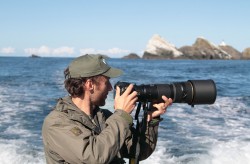
As a personal preference and balance of comfort, functionality and practicality I find that this really is a superb all-rounder. Only on the wildest of Shetland winter days do I need to opt for a ‘heavier’ outer layer. With a good base and under layer I find it very light, cosy and windproof. It is more than up to the job in wet weather too. By layering up under the smock I certainly get good use out of it and possibly trust too much in it, but that’s simply because it’s up to the mark. The only issues I have found in wearing it in the wilder weathers is that it lacks the external pocket for a bit of hand warming (although by opening side vents you can access inside pockets) and also perhaps most notable is that as a consequence of its wonderfully light material it is quite prone to catching the wind and thus quite noisy.
But these can hardly be used against it nor seen as a disadvantage as essentially it‘s not designed for these conditions. If anything the very fact I often wear it in such conditions is a testament to its versatility in itself.
In milder summer and warmer weather (conditions which are unfortunately all too often rare here in Shetland!), this is the perfect piece for me and potentially where it comes into its own. A single base layer or T shirt with the smock is pretty much all I find I need to wear during the summer months. In the warmer days I never feel sweaty or clammy in it and find that with the side vents open its ideal for all day wear.
Yes indeed, this is my favourite Paramo piece to date, although there are more items on their way…
We are proud members of the Páramo Nature Pro scheme.
Permalink
Stealth Gear Smock – Review
Posted by Brydon Thomason on Sunday 29th May 2011 | Reviews
My introduction to Stealth Gear was with the Extreme Jacket Vest (and trousers). The jacket was like no other I had worn in terms of functionality, build quality and design. I had only been wearing the jacket for a matter of months when the Smock was launched.
Needless to say I couldn’t help myself and was enthusiastically intrigued to try it out, especially as the Smock was much more the style of jacket I typically prefer. I’m not entirely sure why this is maybe just the general fit that the style of a smock offers. In the past I have owned several ‘smocks’ of different designs, brands and materials.
When I unpacked it and before I had even tried it on I knew it would be my new favourite SG garment. The fact that it was noticeably lighter weight was the first thing I noticed and liked. One large pocket on the front replaced the many different pockets offered in the other jackets whilst there was splendid ‘hand warmer’ sized and lined pockets at either side. In short (and from a personal perspective) it was a much simpler and snugger fitting and slightly lighter weight option to the other jackets in the SG range.
The ‘kangaroo’s pouch’ style front pocket is certainly roomy to say the least and can easily manage mid-range sized lens and DSLR body. I personally however find it best for carrying my binoculars. I have lost count of the number of times I have laid off my bins whilst my adrenalin levels were peaking during a lengthy stalk (often crawling) especially whilst photographing Otters, only afterwards having to retrace my path to pick up my ‘bins’.
The only other two pockets are two small zippered breast pockets, either side of the neck zipper, which opens as far as the chest and I find is far enough. These two pockets are perfect size for all I often need/want to carry; my mobile (always on silent!!), spare battery, lens cloth and extra memory cards- inside the SG card wallet of course which is clipped into the small D rings and concealed inside the zipped pocket.
The Smock also comes complete with most other extras the other jackets have such as hood, mozzy/midge face net (which I use more for camouflaging my face), storm cuffs, removable elbow pads and has the same functional arm pit vents and side openings which I have open most of the time for crouching, crawling and extra venting.
I mention its lighter weight; this is because it lacks the multiple layers of material which the multiple extra pockets have on the other jackets. Most of the time I wear it (now bear in mind we are roughly 60 degrees north up here in Shetland!) either with just a T shirt on or just a long sleeve sweater but in winter it works brilliantly with the SG fleece. Needless to say, as with all the ‘gear’ the benefits of the forest green tones and the ‘rustle proof’ material make a world of difference when working with species as shy and secretive as wild Otters (both for me personally and indeed my clients when wearing the gear we supply them with on our workshops).

All in all it a fantastically functional, comfortable and brilliantly designed jacket – in my opinion the best one (or should I say personal favourite) in the Stealth Gear range.
Brydon Thomason
Permalink
Stealth Gear Double Bean Bag – Review
Posted by Brydon Thomason on Sunday 29th May 2011 | Reviews
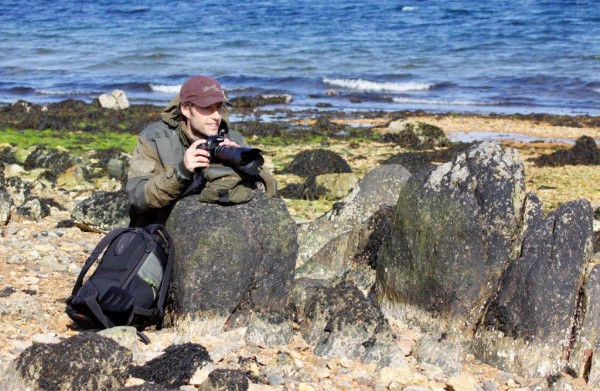
Out of all the kit you feel you should have as a wildlife photographer, a bean bag surely has to be a ‘must have’. Personally speaking I very probably use a bean bag far more than a tripod, whether it be balancing over a barnacle covered boulder in the ebb photographing Otters or out the car window, with camera and also telescope.
As a photographer Otters are undoubtedly my favourite subject and signature species. Perhaps surprisingly to some there are actually few occasions when a tripod may be practically used when stalking Otters (there are however exceptions to this of course). It is imperative that your silhouette blends in and merges into whatever your surroundings may be, whether it be boulders on a shore line or the contours of a grassy bank – your silhouette must not be seen.
With a bean bag it becomes much easier to lay flat or crouch tight against a boulder than if you have a tripod or monopod.
I was thrilled when I became aware that Stealth Gear were launching their own bean bag a few months ago. It came as no surprise what so ever when arriving in the post I saw that its design, engineering and manufacture was (as par for the course with all Stealth Gear products I have been supplied with), nothing but quality.
Previously I have used bean bags but it’s surprising just how many little gripes you can make about a bag of beans! But SG has come up with the good’s and designed a bean bag and (like all their products) that is just for photographers.
The bean bag itself is effectively ‘saddle’ shaped so it hangs/spreads itself very well either on solid ground or a car window. There is good sized zipper on one side which makes it easy to fill and empty when travelling whilst on the other there is a cheeky wee zipper for an accessory pouch.
One of my favourite features is the adjustable strap for carrying which even has a free moving cushioned section for comfort when carrying over the shoulder and for long hikes this is certainly
appreciated, especially as I often end up carrying two, one for myself and one for my Otter photography clients! It also has two different options for the strap to connect.

The general size I found to be just right both for carrying when full and also for what could be used on it; easily large enough for larger lenses such as 300 2.8, 500 and so on. The build quality is superb also and the material is waterproof – all in all it has brought the bean bag forward to a brand new level!
Brydon Thomason
Permalink
Review: Advanced Bird ID Guide by Nils van Duivendijk
Posted by Martin Garner on Thursday 16th December 2010 | Reviews
A Review by Martin Garner
Back in 1980 I wrote a couple of pocket-sized booklets filled with the bullet points of key identification features for lots of really rare birds. Just in case one day I bumped into some of them and couldn’t remember what to look for.
I had a little dream. One day I would publish these little bullet point booklets – surely others beside me would value such a tool. I never got it published. Instead Nils van Duivendijk has done something like it, only made a much better job of it. The Advanced Bird ID Guide is far more comprehensive than anything I had conceived and much nicer looking! If you haven’t seen a copy yet, you may be a little taken a- back. It’s like no other ‘field guide’ indeed, bird book of any kind, which you will have seen before. No illustrations – well apart from 2 plates of comprehensive monochrome topographical illustrations near the start. The rest is text, just text.
Originally published in Dutch in 2002, this English version is extensively updated and superbly edited by Shetland Nature tour leader Rob Fray. Covering some 1,300 species and subspecies, it’s hard to image more detail and data squeezed into such a well organised, compact space.
First feel is of a handy compact, spiral notebook-sized soft back book. An inviting colour front cover with a ‘three- fingered’ adult female harrier – Pallid or Montague’s. These are not always easy so I decided to check the harrier section to see how well it would perform in helping me confirm (or otherwise) my identification hunch. A quick check reveals an immense amount of data on Harriers. And within less than 2 minutes the photo is easily assessed – yes it’s a Montagu’s.
Each species data section has pink, left hand margin highlighting which age/ sex / plumage category is being discussed. Next to this, the bullet point list of characters. This ranges from 2-3 lines (e.g. Mediterranean Strom Petrel) to 1-2 pages (e.g. American Herring Gull).
I have worked with Nils on the very thorny subject of Steppe Buzzard identification. So I am already familiar with this incredible attention to details and sharp eyes. As I have thumbed through the content, again and again I have discovered details about species and subspecies which are well beyond my ever ability to ever commit to memory. It’s hard to see how it won’t quickly become part of my normal kit – one for my car kit bag and one for the book shelf at home. At such a reasonable price too, it’s likely to reduce the hesitation to purchase. So Yes, I am a fan.
On our recent Shetland Nature autumn birding break we even came up with a new verb – ‘to Nils a bird’. Meaning: To gain more information of a bird identification features or perhaps to correctly age it or sex a particular individual– one just needs to ‘Nils it’. A quick and easy process!
Should you get one? No book is truly ‘essential’. But with my book shelves groaning and space at a premium- here is surely the greatest mass of bird identification data in one very small easily accessible place. I can safely say now, that mine won’t be available to be loaned out for the foreseeable future – so you need to get your own! For as little as £10.00 a proper bargain too.
Martin Garner
Permalink
 Clearly a photographic guide was well over due and the recently published Discover Shetland’s Birds: A Photographic Guide to Shetland’s Breeding, Wintering and Migrant Birds has gone way beyond expectations to bridge that gap. Published by ‘Shetland Heritage Publications’ the guide concentrates on about 180 of the 450 species recorded in Shetland. With this the authors Paul Harvey and Rebecca Nason target the species visitors are most likely to see throughout the seasons in the Isles.
Clearly a photographic guide was well over due and the recently published Discover Shetland’s Birds: A Photographic Guide to Shetland’s Breeding, Wintering and Migrant Birds has gone way beyond expectations to bridge that gap. Published by ‘Shetland Heritage Publications’ the guide concentrates on about 180 of the 450 species recorded in Shetland. With this the authors Paul Harvey and Rebecca Nason target the species visitors are most likely to see throughout the seasons in the Isles.

